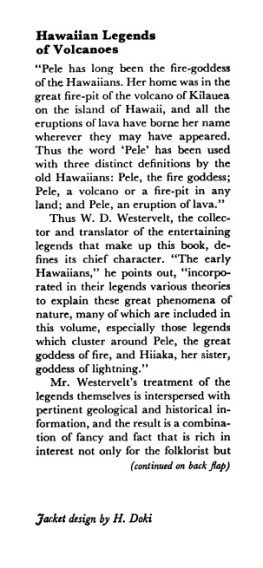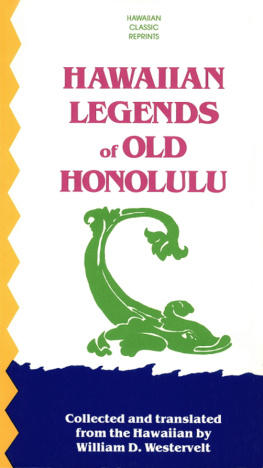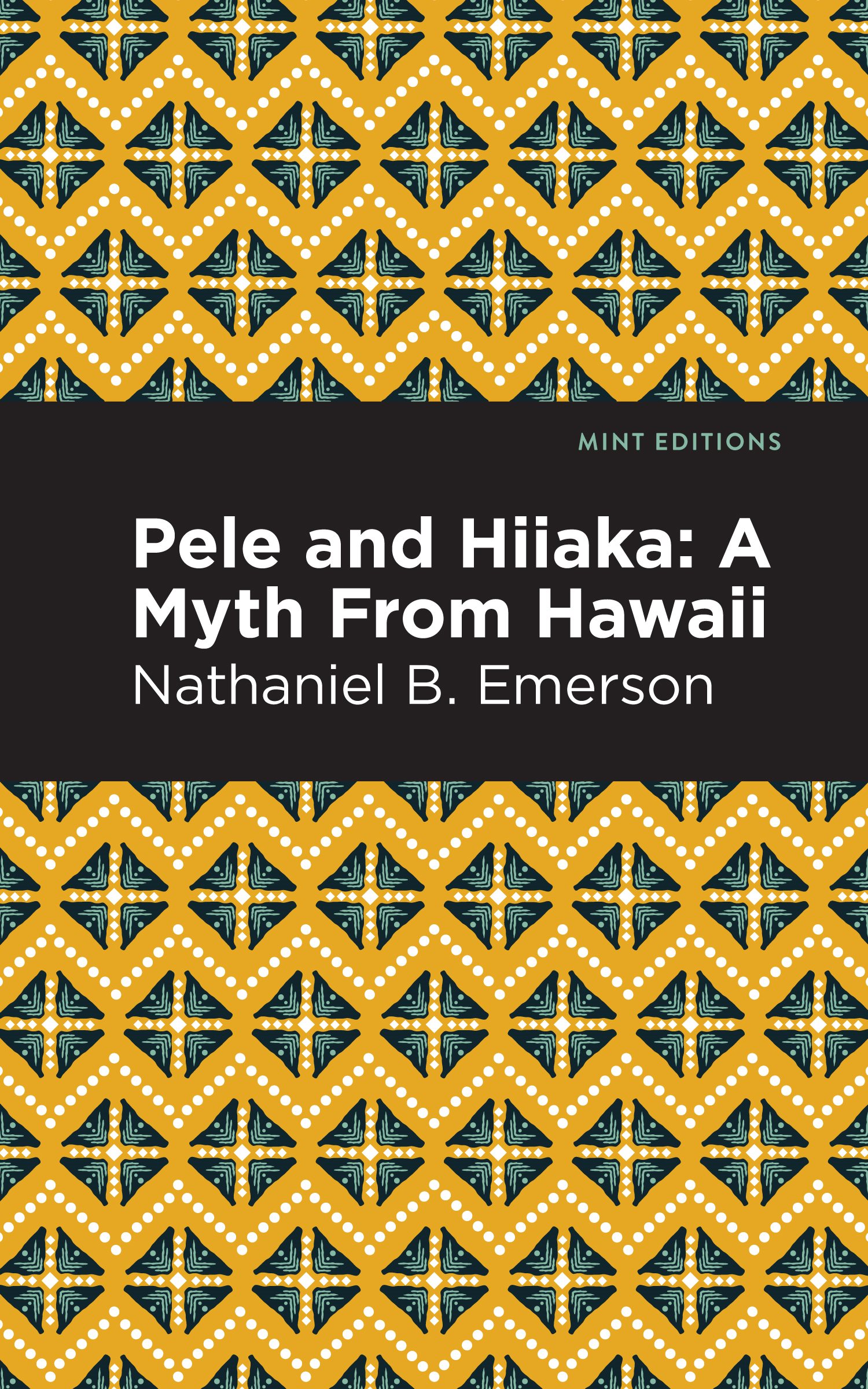PREFACE
The story of Pele and her sister Hiiaka stands at the fountain-head of Hawaiian myth and is the matrix from which the unwritten literature of Hawaii drew its life-blood. The material for the elaboration of this story has, in part, been found in serial contributions to the Hawaiian newspapers during the last few decades; in part, gathered by interviews with the men and women of the older regime, in whose memory it has been stored and, again, in part, it has been supplied by papers solicited from intelligent Hawaiians. The information contained in the notes has been extracted by viva voce appeal to Hawaiians themselves. These last two sources of information will soon be no longer available. Merely as a story, this myth of Pele and her kindred may be deemed to have no compelling merit that should attract one to its reading.
The cycle of world-myth already gathered from the rising to the setting of the sun, from the north pole to the south pole, is quite vast enough, and far in excess of the power of any one scholar to master and digest. It contains enough pretty stories, in all conscience, to satisfy the demands of the whole raft of storiologists and penny-a-liners, ever on the alert to cram the public with new sensations, without making it necessary to levy upon Hawaii for her little contribution. It is not from a disposition to pander to any such appetite that the writer has drudged through many long years in collecting and giving literary shape to the material herein presented. The people who settled the Hawaiian group of islands are recognized as having occupied a unique station, one so far removed from the center and vortex of Polynesian activity as to enable them to cast a highly important side-light on many of the problems yet unsolved, that are of interest to ethnologists and philologists and that still enshroud the Polynesian race. Hawaii rejoiced in a Kamehameha, who, with a strong hand, welded its discordant political elements into one body and made of it a nation. But it was denied a Homer capable of voicing its greatest epic in one song.
The myth of the volcanic queen, like every other important Hawaiian myth, has been handled by many poets and raconteurs, each from his own point of view, influenced, no doubt, by local environment; but there never stood forth one singer with the supreme power to symphonize the jarring notes and combine them into one concordant whole. This fact is a tribute to the independent attitude of Hawaiis geographical units as well as to its scattered minstrelsy. This book does not offer itself as a complete history of Pele; it does not even assume to present all the oli, mele, and pule that deal with the great name of Pele. There were important events in her life that will receive but incidental mention. Of such is the story of Peles relations with the swine-god Kama-puaa. As indicated in the title, the author confines his attention almost wholly to the story of Peles relations with Prince Lohiau of Haena, in which the girl Hiiaka became involved as an accessory.
It was inevitable that such a myth as that of Pele should draw to it and, like an ocean-reef, become the stranding ground of a great mass of flotsam and jetsam poetry and story. Especially was this true of those passional fragments of Hawaiian mele and oli, which, without this, would not easily have found a concrete object to which they might attach themselves. It matters not whether the poet-philosopher, deep pondering on the hot things of love, hit upon Pele as the most striking and appropriate character to serve his purpose and to wear his garment of passionate song and story, or, whether his mind, working more objectively, took Natures suggestion and came to realize that, in the wild play of the volcanic forces, he had exemplified before him a mighty parable of tempestuous love. Certain it is that the volcano was antecedent to the poet and his musings, and it seems more reasonable to suppose that from it came the first suggestion and that his mind, as by a flash of inspiration, began its subjective work as the result of what he saw going on before his eyes. The Hawaiian to whose memory was committed the keeping of an old time mele regarded it as a sacred trust, to be transmitted in its integrity; and he was inclined to look upon every different and contradictory version of that mele as, in a sense, an infringement of his preserve, a desecration of that sacred thing which had been entrusted to him. It resulted from this that such a thing as a company of haku-mele (poets or song-makers) conferring together for the purpose of settling upon one authoritative version of a historic mele was an impossibility.
It is a misfortune when the myth-cycle of any people or country is invaded for exploitation by that class of writers whose sole object is to pander, or caterto use a softer termto the public taste for novelty and sensation, before that cycle has been canvassed and reported upon by students who approach it in a truthful yet sympathetic spirit. In other words: plain exposition should come before sensational exploitation. To reverse the order would be as undesirable as to have Mnchausen gain the ear of the public before Mungo Park, Livingston, Stanley, Cook, or Vancouver had blazed the way and taken their observations. Fortunately for Hawaii, the spirit of the times has set its face like a flint against this sort of sensation-mongering, and if a Mnchausen were now to claim the public ear he would have the searchlight of scientific investigation turned upon him as pitilessly as it was done in the case of an alleged claim to the discovery of the north pole. It is a satisfaction to the author, after having accomplished his pioneer work of opening up a new domain, to bid the public enter in and enjoy the delicious lehua parks once claimed by the girl Hiiaka as her own; and he can assure them that there yet remain many coverts that are full of charm which are to this day unravaged by the fires of Pele. N. B. B.
EMERSON
INTRODUCTION
According to Hawaiian myth, Pele, the volcanic fire-queen and the chief architect of the Hawaiian group, was a foreigner, born in the mystical land of Kuai-he-lani, a land not rooted and anchored to one spot, but that floated free like the Fata Morgana, and that showed itself at times to the eyes of mystics, poets and seers, a garden land, clad with the living glory of trees and habitationsa vision to warm the imagination. The region was known as Kahiki (Kukulu o Kahiki), a name that connotes Java and that is associated with the Asiatic cradle of the Polynesian race. Peles mother was Haumea, a name that crops up as an ancestor in the hoary antiquity of the Hawaiian people, and she was reputed to be the daughter of Kane-hoa-lani. Pele was ambitious from childhood and from the earliest age made it her practice to stick close to her mothers fireplace in company with the fire-keeper Lono-makua, ever watchful of his actions, studious of his methodsan apprenticeship well fitted to serve her in good stead such time as she was to become Hawaiis volcanic fire-queen. This conduct drew upon Pele the suspicion and illwill of her elder sister Na-maka-o-ka-hai, a sea-goddess, who, fathoming the latent ambition of Pele, could not fail to perceive that its attainment would result in great commotion and disturbance in their home-land. Her fears and prognostications proved true.














 Pele and Hiiaka: A Myth From Hawaiiwas first published in 1915.This edition published by Mint Editions 2021.ISBN 9781513299686 | E-ISBN 9781513223728Published by Mint Editions
Pele and Hiiaka: A Myth From Hawaiiwas first published in 1915.This edition published by Mint Editions 2021.ISBN 9781513299686 | E-ISBN 9781513223728Published by Mint Editions minteditionbooks.comPublishing Director: Jennifer NewensDesign & Production: Rachel Lopez MetzgerProject Manager: Micaela ClarkTypesetting: Westchester Publishing Services
minteditionbooks.comPublishing Director: Jennifer NewensDesign & Production: Rachel Lopez MetzgerProject Manager: Micaela ClarkTypesetting: Westchester Publishing Services